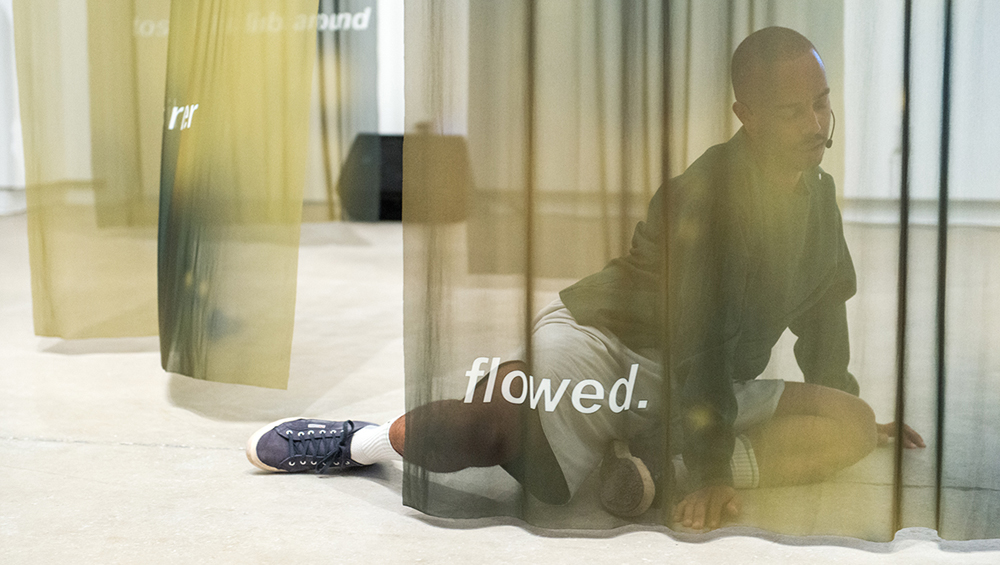
by VERONICA SIMPSON
Paul Maheke (b1985, Brive-la-Gaillarde, France) has conjured some fierce visions for his first fully choreographed performance piece: a possessed drag king who strips down to his/her silvery briefs; a voluptuous, teasing tap-dancer who never quite dances; a female oracle whose slender presence slides between calm prophecy and demonic intensity. A Fire Circle for a Public Hearing (2018) debuted at the Chisenhale Gallery this spring, having evolved over the course of a three-month Chisenhale-supported residency spent in the Dominican Republic. In this new work, Maheke has taken his preoccupations with visibility and invisibility - exploring the unspoken rules about what is and isn’t acceptable within the norms of gender and race identity - but instead of using his own body to explore these boundaries, he has placed the role of provocateur firmly in the hands of three female artists who act out a variety of archetypes, from drag king through oracle to magician.
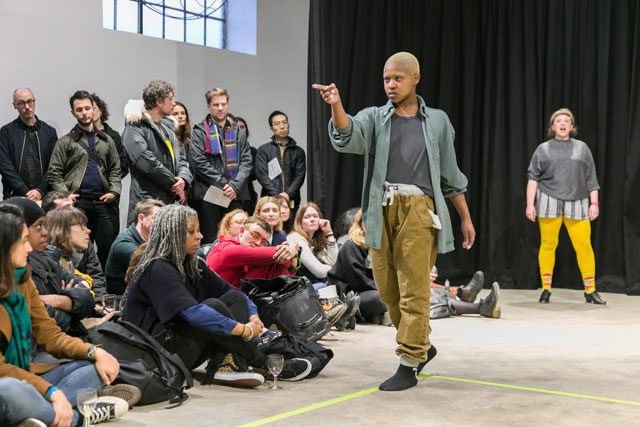
Layo (Titilayo Adebayo) and Carrie Topley performing, Paul Maheke, A fire circle for a public hearing, 2018, Chisenhale Gallery, 2018.
Moments of pop culture – such as moves from Michael Jackson’s 1992-93 Dangerous world tour – are layered with spoken word, sound and elements of the performers’ own practices as musicians, artists, actors and dancers. Three different performance “chapters” are planned over the eight-week course of the show, Parts 1, 2 and 3. Part 1, which ran from the opening on 13 April until early May, was structured around a homage to performance artist Felix Gonzalez-Torres’s 1991 piece, Untitled (Go-Go Dancing platform) – although this time with the lithe, clearly female, albeit with an androgynously muscular body, performer Layo (Titilayo Adebayo) playing the role of the silver jockey-shorted bump-and-grind artist, complete with fake “penis packer”. She also recreates part of Bruce Nauman’s work Walking in an Exaggerated Manner Around the Perimeter of a Square (1967), with lime-green gaffer tape. The spoken word element is a text developed by Maheke that mixes personal reminiscence with poetry and classical references, and all of this set against a pulsing, haunting soundtrack co-devised with Sophie Mallett.
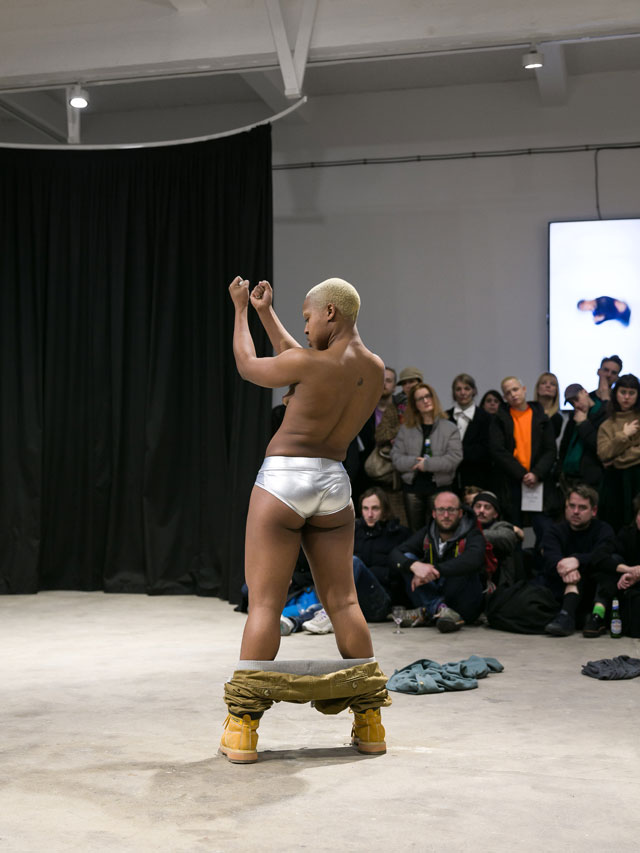
Layo (Titilayo Adebayo) performing as go-go dancer, Paul Maheke, A fire circle for a public hearing, 2018, Chisenhale Gallery, 2018.
The performance occurs daily at 3pm and last for 45 minutes, but the setting is also intriguing on its own: for this show, the Chisenhale gallery has been stripped back, its windows revealed, and metal grilles placed over them to evoke both angelic (religious) and prison typologies. These grilles are designed with the colonial architecture of the Caribbean in mind – a part of the world Maheke is drawn to for its narratives of trauma through slavery and colonialization, as well as for its multicultural energy and dynamism.
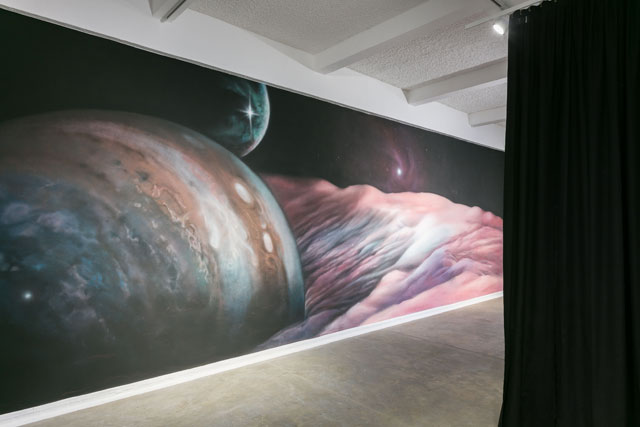
Paul Maheke, Jupiter painting, A fire circle for a public hearing, 2018, installation view, Chisenhale Gallery, 2018.
Maheke has tried to eliminate the barrier between gallery and public space, by removing the doors and window coverings. The first artwork encountered is a sherbet-hued fantasy landscape of the planet Jupiter surrounded by cosmic fog, planets and stars, painted on to the back wall; he has stated before his fascination with speculative belief systems such as cosmology and astrology. Heavy black backstage drapes curve around the space, hung from the ceiling. On one side, they frame a large, heavy, wooden tiered seating platform – which has a watchful presence, whether occupied or not - while in the far corner, Maheke’s own figure is viewed spinning and gyrating on a screen in a looped performance that also ties in with the soundtrack.
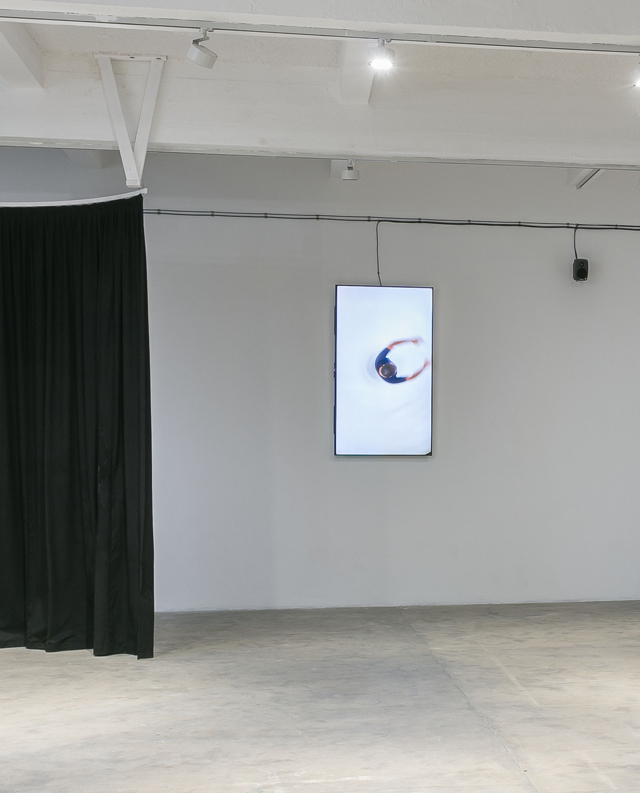
Screen showing Paul Maheke dancing, installation view, Chisenhale Gallery, 2018.
In the programme accompanying the exhibition, Maheke tells curator Ellen Greig: “Through this exhibition I hope to explore a tension between moments of erasure and hypervisibility, and the seeming impossibility of escaping this pattern when black and queer in the west.”
Maheke studied for his BA and MA at the École Nationale Supérieure d’Arts de Paris-Cergy, and then joined the master’s programme at Open School East in Margate, Kent, which he completed in 2015. He spent six months as the South London Gallery’s graduate in residence, culminating in his first solo show, I Lost Track of the Swarm (2016), which was followed by Unwritten Handbook: Paul Maheke, at the Serpentine (2016). In spring 2017, Maheke performed Mbu at Tate Modern’s BMW Live events in the Tanks, and again at the Walker Art Gallery’s Coming Out: Sexuality, Gender and Identity exhibition in Liverpool. His work The River Asked for a Kiss (2017) was shown at the Venice Biennale, as part of the Diaspora Pavilion. He has participated in group shows in Santander, Copenhagen, Paris and London, and will be performing at the Kunsten Festival, La Raffinerie, Brussels, as part of Move, at the Centre Pompidou, and at the Baltic Triennial 13: Give Up the Ghost, in Tallinn, Estonia. He lives and works in London and is represented by Galerie Sultana, Paris.
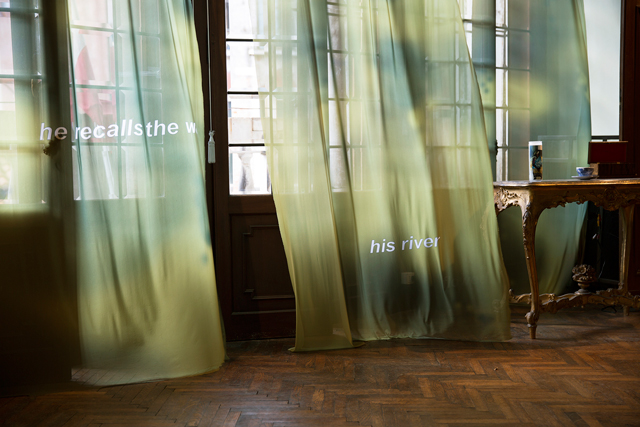
Paul Maheke. The River Asked for a Kiss, 2017. Diaspora Pavilion, Venice Biennale 2017. Courtesy of the artist.
Veronica Simpson: You have said that the opportunity to choreograph your work for others to perform is an exciting new departure for you. Is your previous work - where you use your own body to express what you are trying to say – not choreography, too?
Paul Maheke: Most of the time I’ve performed before, the work was based on improvisation - maybe including a few tasks, but not really researching movements, because I didn’t have the infrastructure to do it, or the support system. My studio is small and most of the time I’m performing in art venues that don’t have facilities to produce movement-based work. This was the first time that I have had time, over the last three months of this residency, and space as well, to experiment with movement. So, I’ve researched specific things, mainly in connection to a few pop idols, drawing from those movements somehow. There is, for example, this idea in this first part at the Chisenhale of a dancer dropping in and out of a movement and in and out of a character.
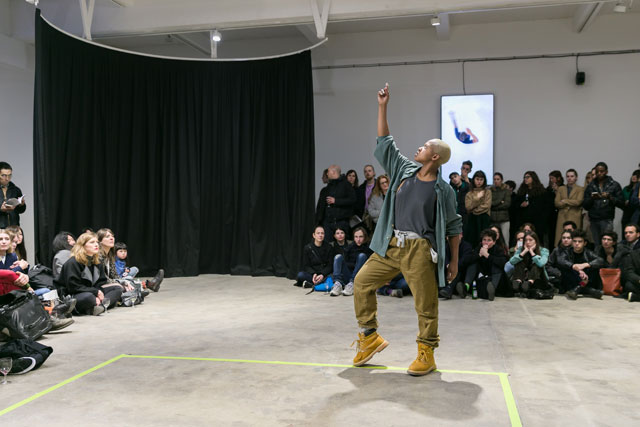
Layo (Titilayo Adebayo) channeling Michael Jackson, Paul Maheke, A fire circle for a public hearing, 2018, Chisenhale Gallery, 2018.
In the script, there is also the idea that movements are mutating throughout the full duration of the performance: from Bruce Nauman to the go-go dancer of Felix Gonzalez-Torres, and then via Michael Jackson. I was interested in seeing how those male characters could meet in a body that speaks to masculinity in a different way, because of gender and representations.
VS: How did you find and choose these performers?
PM: We did a casting. We sent out a callout, maybe six months ago, and then we auditioned. At first, I had the idea of having only one performer, but then I met with Layo [dance artist Titilayo Adebayo], Carrie [Topley, performance artist, violinist, singer] and Heather [Agyepong, visual artist and performer] and felt that their personalities and where they were coming from in terms of their practices could be really interesting. Putting the three of them together made sense, especially in relationship to what I’m trying to do regarding identity and this conversation around identity and multiplicity.
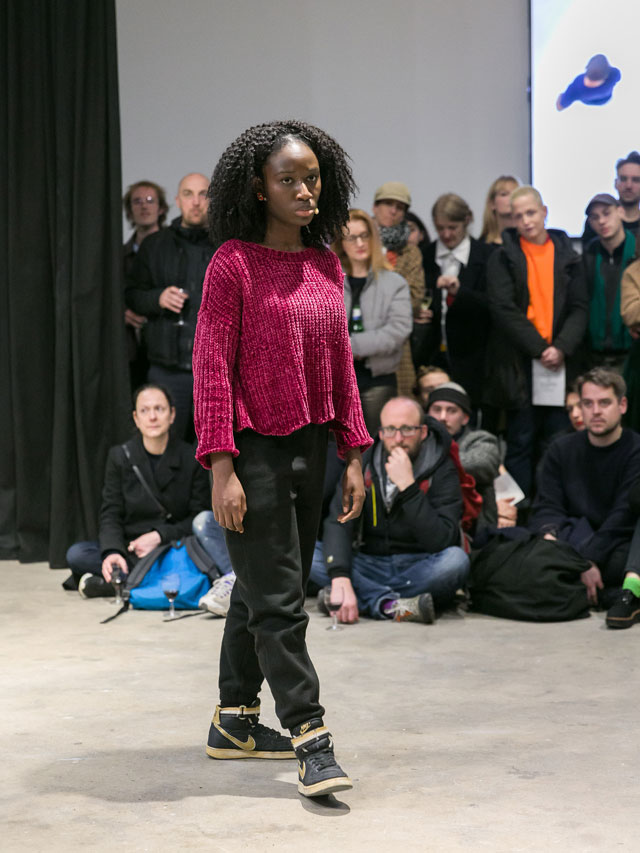
Heather Agyepong performing as Oracle, Paul Maheke, A fire circle for a public hearing, 2018, Chisenhale Gallery, 2018.
VS: How was it for you being able to sit back and watch the performance? At the opening, you seemed to be enjoying that unusual role as audience rather than participant?
PM: I was nervous actually, but more nervous for them. I am really prone to stage fright. But it was good and funny. Heather said she was sure everyone would be expecting me to perform, and when I arrived in the room everyone looked at me, like: is he going to perform? That was a funny thing to notice. And there is a reason why I wanted the work to be interpreted by other people than myself. I didn’t want this work to be attached to my body or what I represent.
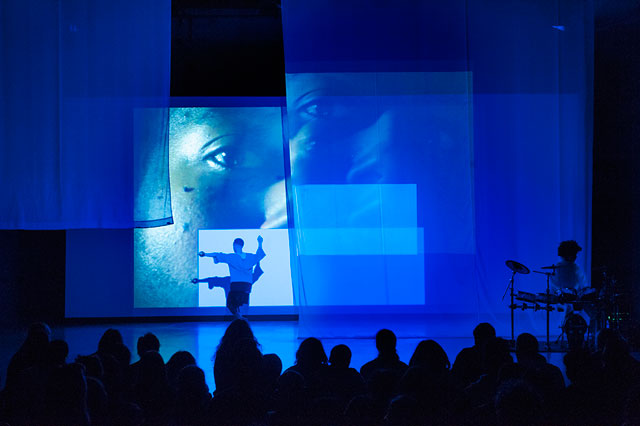
Paul Maheke. Mbu, 2017. Performance, BMW Tate Live Exhibition: Ten Days Six Nights, Tate Modern, London, 2017. Photograph © Tate 2017 (Photographer: Brotherton-Lock). Courtesy of the artist.
VS: How important is feedback or the audience’s response to you as a performance artist? One is always aware of the energy in the room, and it can be quite a powerful additional element.
PM: It was good, but it was also hard to say if people were interested. You understand that they’re interested because they stay. For me, it was a relief not to be in the centre and having to perform. With the feedback, I haven’t had that many conversations around the work because it’s still very fresh. I think it will take me a while to realise what this work is in relation to a broader understanding of my practice. But during the opening I felt that it was important for me that this work exists. And it was nice to see that coming together. It’s a very new thing: the territory that I’ve been exploring for this specific project is different from what I’ve been doing before; the modes of address and forms of speech I’m using are very different.
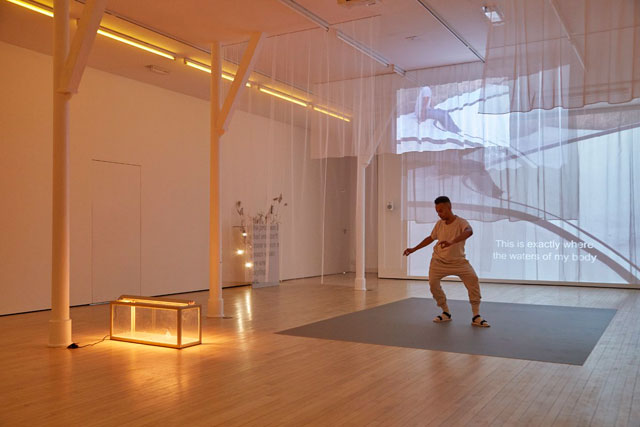
Paul Maheke. What Flows Through and Across, 2017. Assembly Point, London, 2017. Courtesy of the artist.
VS: I am fascinated by your interrogations of what it is to be black and gay and male, and all the codes and restrictions that western norms bring to these issues. In that context, it was doubly interesting, in researching for this interview, to see some clips from Michael Jackson’s Dangerous Tour. His whole persona is completely gender fluid – he wears a macho military jacket, but covered in sequins, a silver jock strap that is about as asexual an adornment as a jockstrap could be. He has had such a huge impact as a dancer, and singer, but I never thought until now what an impact he might have for a young man exploring issues of identity.
PM: Michael Jackson is the reason why I dance. And Felix Gonzalez-Torres is the reason why I still believe in the political potency of making art. But I was more interested in the rehearsals of the Dangerous Tour (than the finished show) because I am interested in the underperformed quality of the movements, not really about the way Jackson was working with his dancers. I’m also interested in the coexistence in time of that specific tour with Gonzalez-Torres’s Go-Go Dancing Platform as well as the impossibility of emptying out both Jackson’s and Gonzalez-Torres’s work from their substance; for Gonzalez-Torres because all the works are reproducible and are made so they can be reproduced endlessly even after the physical death of the artist; for Jackson, it’s more metaphorical and has to do with his singularity and genius as well as his unlocated blackness/queerness … the way he is slipping through the cracks of categorisation and binaries.
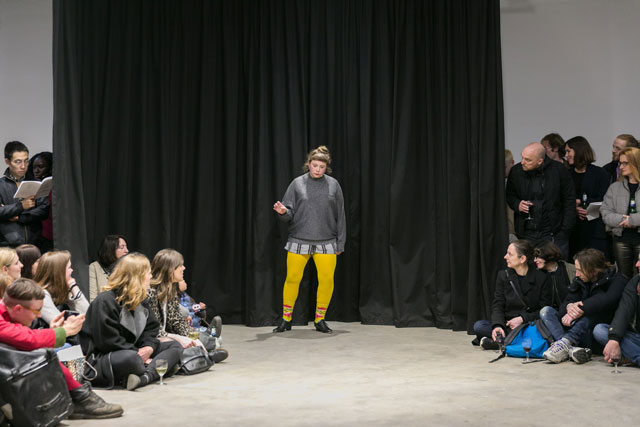
Carrie Topley performing, Paul Maheke, A fire circle for a public hearing, 2018, Chisenhale Gallery, 2018.
VS: But there is something so interesting about giving these gestures and poses to women, while allowing them to express their own ferocious energy.
PM: I knew that this figure I was interested in from the beginning of the production process, that one voice that would embody the show somehow - activate the show - would be a figure of power. That’s why I didn’t want a male or a man to do that, but someone who was identifying on the femme scope of identity.
VS: They expressed several points along the spectrum during that performance.
PM: Across the group, there are different levels of queerness that are more or less visible and I was interested in that. But all three are extremely positioned in the world, and opinionated and positioned according to their practice. I knew those figures could only be figures of power. So that’s what I was trying to do: to nurture that sense of empowerment. Also, because Heather really embodies … the oracle; she says at one point: “I am the lived and experienced knowledge.”
Then, lastly, there is this character of the ghost: these figures that they are supposed to be.
VS: Can you clarify what you mean by this figure of the ghost?
PM: I used the figure of the ghost to speak about identity. These three characters that they represent are living on three different lines and dimensions that at times overlap. And there was a similar thing with the audience: I worked around the relationship between the performers and the audience. How you can pass through someone … Whether the space is full with people or empty, the performance will still happen in the same way. I guess that’s why I connect back to the ghost.
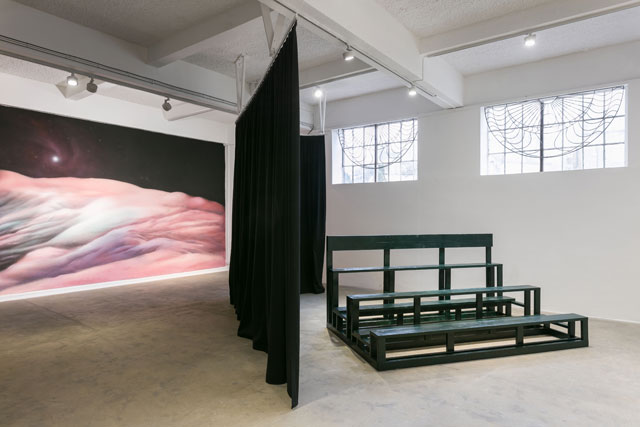
Paul Maheke, A fire circle for a public hearing, 2018. Installation view, Chisenhale Gallery, 2018. Photograph: Mark Blower.
For me, the actual ghost is the presence in the space. There are many: all the objects in the space are some sort of ghost. The railings, they speak to colonial history in the Caribbean. But, also, things such as my presence on the screen. And there are also ghost stories in the script, the three parts. For the second part, Carrie is going to embody a medium, a psychic who will do a performative reading of the Chisenhale space, as if she’s investigating the ghost of the Chisenhale space. That was a way for me to think about what the quality of that space is, how we can work around fictions in that space that are not directly connected to the art, but maybe can still speak about it and many other issues.
VS: What about Part 3?
PM: The third part is still in the making, to be honest. All the ideas are in place; it’s just a matter of communicating that to the performers in a manner that would be understandable.
VS: How does the soundtrack support the work?
PM: Sophie, who composed the soundtrack worked with a certain type of resonances that are only appearing once the sound is in the space, so there are some sounds that don’t exist on the track but they exist in the space because of the resonance.
VS: Like harmonics?
PM: Exactly.
VS: It was really interesting the way the throbbing of the soundtrack, like a slowed heartbeat or drumbeat, heightens the tension. There were many moments of tension and discomfort as we watched the performers, both when they were doing something but also when they seemed to be doing nothing. That discomfort was a real presence in the room as people were trying to work out what was going on. What role does discomfort play in your art?
PM: It’s not the first intention that I have to make people uncomfortable, but there’s clearly something that I’m interested in acknowledging through the work, whether it’s a performance or not: those tensions that exist between me and an audience, or us as bodies in a space. Maybe that’s where the discomfort comes in. But above that thing of discomfort, it’s funny, I always think about how I would welcome people in a space. I am never trying to create hostile spaces. I am somehow trying to allow people to have access to what I’m producing. It’s really important to me to host an audience. It’s never coming from a place of creating discomfort on purpose. But, yes, I’m working around things that acknowledge the difficulties.
VS: And how do you work out the right duration for a piece. This is a long one for you, at 45 minutes. Do you feel that a work maybe has to be a certain length so that people have committed enough of their time and themselves that they will definitely invest in figuring out what it means for them?
PM: This is quite long for me in terms of format. I’m always around the 20 minutes. When I think of myself as a member of an audience, whether I’m in the cinema, or at a concert or something, I like to have space to think about what I’m seeing while I’m still there. (The narratives) I am working with are very complicated, intricate, layered, dense and you need that time to process and absorb it so you can leave the space with something. For me, that is what art is about: gathering people together around an object of whatever kind, to discuss it and to trigger conversations.
• A Fire Circle for a Public Hearing (2018) is at the Chisenhale Gallery, London, until 10 June 2018.